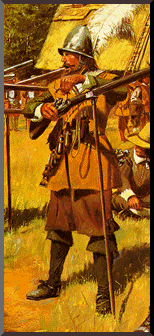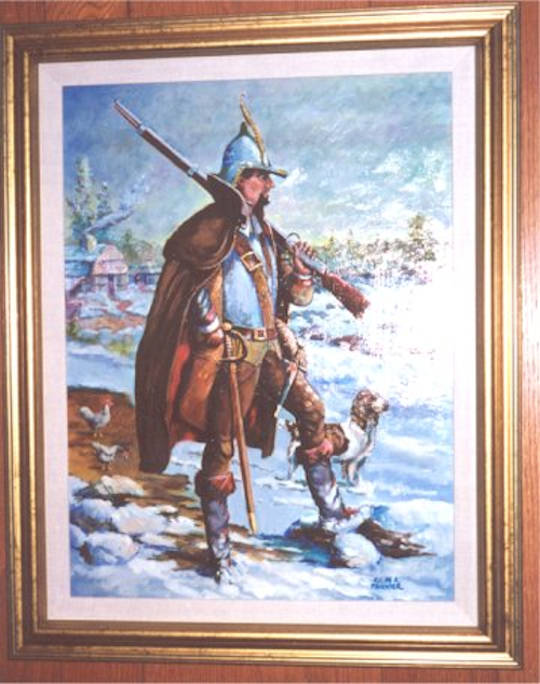|
|
|
Capt. John Underhill
(1608/9-1672)
 |
Founder of the oldest and largest Underhill family in the U. S. and Canada. Born in the Netherlands to English parents, he became a professional soldier and was brought to Massachusetts in 1630 to train the colony’s militia. He resided in Boston, MA; Dover, NH; Stamford, CT; New Amsterdam; and Flushing, Southold, Setauket, and Oyster Bay, all on Long Island, NY.
Cadet in the Guard of the Prince of Orange 1628, Captain Pequot War 1637, Indian War 1643-4, Anglo-Dutch War 1653. Member General Courts (Legislatures) of Massachusetts Bay and New Haven, Council of New Netherland, and Hempstead Convention of 1665; Selectman of Boston, Governor of Dover, Sheriff of Flushing, High Constable and Undersheriff of North Riding of Yorkshire on LI. Author of Newes from America 1638.
Attorney for Matinecock Indians who gave him 150 acres near Oyster Bay, named "Killingworth" after his father’s birthplace, and where he lived and lies buried. His family was among the earliest Quakers. First wife Helena de Hooch, second wife Elizabeth Feake (her mother was Anya Seton’s heroine in The Winthrop Woman). Descendants spread up Hudson Valley to Vermont, across New York to Ohio, and throughout the West.
|
Captain John Underhill’s Birthdate. Although Capt. John Underhill of New York appears in numerous records of his time until 1995 no record had been found which gave any clue as to his birthdate. Nineteenth-century Underhill family genealogists decided that he probably was born about 1597, and someone dreamed up from this an exact birthdate of October 7, 1597, which is unfortunately cast in bronze on the monument erected in 1909 over his grave.
In 1995 research at the Newport (R.I.) Historical Society disclosed, among some original court papers, a deposition made on 30 July 1655 by “Captaine John Underhill aged about 46 years.” The document bears the Captain’s well-known signature and there is no reason to doubt its authenticity. If he was age 46 in July 1655, Captain John was born in the latter half of 1608 or the first half of 1609, when his mother was living at Bergen-op-Zoom in the Netherlands (it was previously assumed that he was born in England). His father died in October 1608, so it is possible that he was a posthumous child. Given this birthdate, he was 19 or 20 when first married, 21 or 22 when hired to train the Massachusetts militia, 28 or 29 during the Pequot War, 50 or 51 when he remarried, and 63 or 64 when he died, having recently fathered his last child. The previously claimed birthdate of 1597 would have made him 11 or 12 years older at each of these events.
For additional information see Harry Macy, Jr., “Captain John Underhill Revised,” The New York Genealogical and Biographical Record, 127:22-23, January 1996, and “Document Casts New Light on Captain John Underhill,” News & Views of the Underhill Society, Spring 1996, pp. 1, 12.
From Foreword by Harry Macy, Underhill Genealogy Vol. 7 (2002)
|
|
The portrait in question
|
THERE IS NO PORTRAIT OF CAPT. JOHN
By Harry Macy, Jr.
The Society is often asked about the alleged portrait of Captain John Underhill of New York, first presented to the public in 1932 as the frontispiece to both Volume 1 of the Underhill Genealogy and Henry C. Shelley’s biography John Underhill Captain of New England and New Netherland. The portrait has since been reproduced in many other publications. Many Underhills have displayed copies of it in their homes, and there are descendants who have felt that they resembled this likeness of their ancestor.
However, in 1976 the Society quietly stopped using the portrait, after it became apparent that it was a fraud.
According to the Society’s Annual Report for 1932, the portrait was discovered in London in 1928 by an art dealer employed by Myron C. Taylor, who brought it back to America and displayed it in his home at Locust Valley, Long Island. The portrait was unsigned, but the dealer thought that it was either by Van Dyke, Mireveldt, or Janssen.
|
It was allegedly painted in 1638 when Captain John Underhill made a return visit to London.
In the version of the portrait published in 1932 the words "John Underhill of Warwickshire" appear in the upper right portion, but these are not found on the portrait itself. On the back of the portrait was a label (reproduced on the reverse of the frontispiece to Volume 1) which reads as follows:
"A Portrait of John Underhill Esq. of Warwickshire son of Thomas of Barton on the Heath and brother of Sir Edward Underhill Kt of Eatington. He, John, went to New England with Governor Winthrop to train the people in military discipline and was appointed Captain in command of the New England detachment by Sir Henry Vane. He was made Governor of Dover in Piscataqua. He died at Killingworth 1672."
A second label reads "Relined and restored October 1866."
The unexpected appearance of this portrait was met with surprise and also with some skepticism since there was no provenance to show where the picture had been for nearly three hundred years, and no known Underhill will, inventory, or other family document had ever mentioned its existence. Among those who were skeptical was the scholar John H. Morrison, whom Mr. Taylor had commissioned to research the Underhill ancestry in England. In his 1932 book, The Underhills of Warwickshire Morrison makes no mention of any portrait of the Captain.
In spite of this Mr. Taylor had the portrait published, and it hung in his house at Locust Valley until his death in 1960, after which it became the property of the Society for the Preservation of Long Island Antiquities (SPLIA), which still owns it and displayed it for many years.
When I first began to research my Underhill ancestry in the 1950s, I was naturally much interested in the portrait, as relatively few ancestral likenesses survive from colonial times. I noticed, however, that the label identifying the portrait was in a much later handwriting than that of the 1630s. The names of the Captain’s father and brother given in the label are incorrect but match the names given in the Captain’s biography published in 1882 in the British Dictionary of National Biography (the correct ancestry remained unknown until the research of Mr. Morrison). It, therefore, appeared that the label might be younger than the painting by at least 274 years.
The mystery deepened around 1966 when my mother saw a color reproduction of the portrait on display in the gift shop of Burdine’s, a Miami department store. There was a label on the back in a language which she couldn’t read, but it clearly did not mention the name Underhill. On my next trip to Florida, I went to the store and found that the label, in Italian, stated that this was a copy of Van Dyke’s portrait of Viscount Stafford, from the original now in the Museum of Art, São Paulo, Brazil.
At the New York Public Library I read the Dictionary of National Biography’s account of Stafford, which identified him as William Henry Howard (1614-1680), a member of the well-known Howard family whose senior member is the Duke of Norfolk. The account revealed that he was twice painted by Van Dyke, one portrait then (1882) being owned by the Marquis of Bute and the other by the Duke of Norfolk. It is the latter portrait that we are concerned with. It was reproduced in 1908 in Brenan and Statham’s The House of Howard, but as an engraving in which the features are slightly distorted so that I was still uncertain, it was the same portrait.
About 1973 I noticed an entry in the catalog of a New York print shop for a copy of Van Dyke’s Viscount Stafford. This turned out to be a full-color reproduction (printed in Italy from the original at São Paulo), and it matched the alleged Underhill portrait exactly. There was no longer any question that the alleged portrait of Captain John Underhill was a copy of Van Dyke’s portrait of Viscount Stafford. I purchased a copy of this print and it is now in the collection of the Society.
About 1980 a representative of SPLIA advised me that tests on the portrait in their possession had shown that the paint was about 100 years old, not 300. Tests on other alleged 16th and 17th century Underhill portraits given to SPLIA from the Taylor estate showed similar results (for these portraits see the Bulletin,
|
 An Artist’s Conception of Captain John Underhill An Artist’s Conception of Captain John Underhill
At the First Muster
By Artist RALPH FOURNIER, AIA
In the preparation and research for this painting, we have made assumptions as to what we believe a rough colonial soldier would look like. We know where he lived and what his career was. We know from history that he called the "First Muster" of the Militia on the commons at Salem, MA. From here on we have made assumptions of an officer at that time. This all we have to go on, but we came pretty close so that the Underhill Society will have some indication of what our founder looked like at that time in his life. His age was 39 years at the time of this muster.
UNIFORM: The British War Museum advised us that the field uniform of the Queen’s forces in Holland, where Capt. John served, is as shown in the painting. His helmet carries a Pheasant feather denoting the rank of captain.
ARMAMENT: He carries a field piece similar to that issued in Holland. As a side piece, he carries a combat knife. We can assume that he brought these to the new colony in America.
FACIAL DETAILS: We gave him the Underhill nose, clean-shaven with a ruddy complexion. Since he was raised in Holland, a goatee was added.
HIS BODY: We are advised that most military men of that time were 5’10" tall. So we made Captain John that size.
PAINTING BACKGROUND: We faced Capt John looking out to Massachusetts Bay from the Commons at Salem. This is where the fortifications were to be on the south side of Boston with Marblehead to the north.
The colonists had more than Indians to contend with. The King had indicated he would revoke the charter of the colony and fortifications were to be placed at these two locations.
Since it was December, we put snow on the ground. We show a chicken and we know that they brought White Leghorns with them. Dogs were important for field hunting for grouse, pheasant, and woodchuck. The only breed that was in use in England at that time was the English Springer Spaniel. The houses in the background are authentic for that period.
N. Robert Underhill
|
|
|